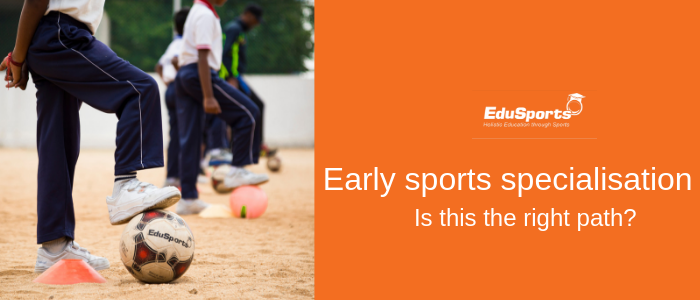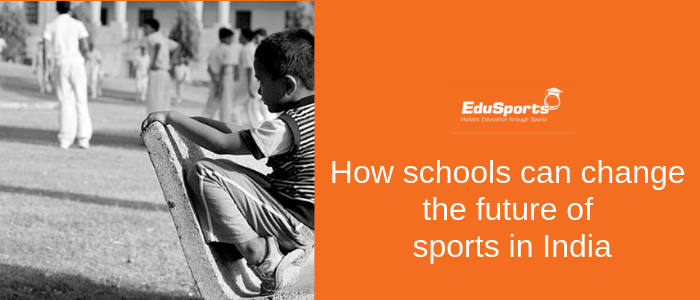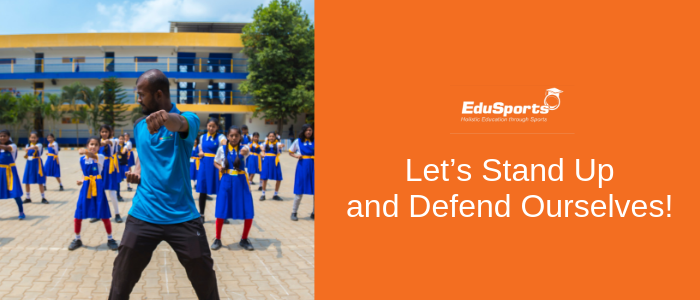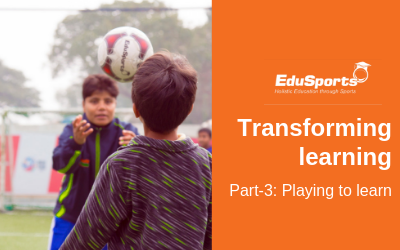“To succeed is to have failed” – learning from failures
Category: Uncategorized

Early sports specialisation – Is this the right path?
Steffi Graf started practicing on a court at the age of four, played her first tournament at five and turned pro at 13 years of age. Nadia Comaneci was 14 when she created history by scoring a perfect 10 in Gymnastics at the 1972 Olympics. Some of the successes that the Chinese athletes have recently experienced can be attributed to their early sports specialization and rigorous practice. But is early specialization, towards any sport, the right direction for a child?
Whilst several pieces of evidence; specifically, in sports like gymnastics and swimming, justifies the importance of early sports specialization, there are cases, particularly in sports like football and basketball, wherein exposure to multiple sports at an early age has resulted in players acing a particular sport at the later stage. For instance, former NBA star and two-time Most Valuable Player (MVP) awardee, Steve Nash got his first basketball when he was 13 years old. He has always credited his background in soccer for making him a great basketball player.
Studies have shown that several successful athletes, performing at the ‘elite’ level, have a strong physiological foundation due to their exposure to multiple sports at their early training stages. Various personalities like Pete Carroll, former USC and Seattle Seahawks Football coach said, “The initial questions I often ask about a kid are, ‘What other sports does he play? What does he do? What are his positions?” It has been medically, scientifically, and psychologically recommended that the best way to develop all-round athleticism in a child is ample free play and sports diversification.
Though there are several benefits, early specialization has also been associated with the frequent, rigorous and intense practice, often straining the children/young athletes both physically and mentally. Several swimming coaches are known to train kids, as young as 8 years, for approximately 9 hours per week, covering an average of 14kms. Former tennis player, Andre Agassi’s autobiography titled ‘Open: An Autobiography’, discusses the trauma that he experienced, because of being pushed by his overbearing father, to an extent that he did not enjoy the sport. Furthermore, the early success experienced by Boris Becker and Steffi Graf led to an extensive list of early sports pros, including Jennifer Capriati who struggled with various injuries, emotional issues, and drug abuse.
When does the fun activity of playing a sport, turn into something serious that takes away the joy of playing? Dr. Selleck has defined fun as an activity when an individual is fully engaged, entirely connected to his/her co-players and stretched a little bit beyond his/her limits.
After winning the 2012 NBA championship, Lebron James and Dwyane Wade were asked about the sports they played as children? To which they reminisced all the games that they created on the fly, with one common theme – “fun”. The idea of having fun while playing was very prominent in nearly every conversation with the top 100 athletes whom Ethan J Skolnick and Dr. Andrea Corn had interviewed for their book titled, “How to raise your game.”
There is a school of thought that believes most sportspersons fade away once they reach thirty. However, with Roger Federer continuing to win Grand Slams well into his thirties and MS Dhoni looking sharper than any other young wicket-keeper behind the stumps, this belief is being questioned.
Children have fun when they are learning something new. Exposure to multiple sports often results in children creating their own games. It stops being fun when a child feels playing a sport is no different than carrying out a task.
It is recommended that kids should be exposed to a fun environment so that they can experience the magic of sports, through the right level of encouragement and support, from schools, parents, and coaches.
As Steve Nash rightly said: “Encourage, support and be there for them, make it fun, and then you’ve got a better chance for a kid to gravitate towards sports. And hopefully away from some other things.”
https://schools.sportzvillage.com///wp-content/uploads/2021/04/Krish-Iyengar.png" alt="" width="112" height="150" />
Author
Krish Iyengar
Business Head, EduSports

How schools can change the future of sports in India
How schools can change the future of sports in India Where do children play?
Everyone seems to agree that children should play, and that more children should play as often as possible. However, the problem is not “Why should children play?” The real problem is “Where?”
With increasing urbanization, open spaces are disappearing in cities as well as smaller towns. Also, with increasing traffic congestion, the commute time for parents and children is a hassle. Children spend an hour travelling to-and-from the sports venue. In addition, the parent must arrange transport or drive the child and wait around while the child plays. Most parents do not have such a luxury of time or resources.
Therefore, due to a combination of disappearing open spaces/playgrounds near our homes and the hassles involved in commute, children are not playing as much as they used to a generation ago. This has contributed to significant increase in obesity levels, mental disorders and lack of social skills amongst children.
However, there is a clear solution. Schools present the scalable and sustainable solution for getting children to play. Schools can solve these problems by making sports an integral part of education.
Aggregation of children:
Every class has 25-50 children of a similar age, height and weight category and they show up every day, throughout the year. No separate transport logistics need to be managed or ongoing marketing needs to be in place to ensure children show up. There is a Physical Education timetable that runs round the year.
Synchronization of children:
Physical Education (PE) & Sports is mandatory in all schools (though it is often followed merely in letter than in spirit). So, all the children in a class come out at the same time during their PE/Sports period.
Space:
Most schools do have some space for children to play. Programs can be structured and designed to make effective use of limited time and space.
Fees:
Sports and PE is an integral part of Education. Parents pay fees and the fees cover PE and Sports for all children, along with other studies. Parents expect their child to be taught Physical Education and Sports with the same structure, rigour, individual assessment, daily lesson plans and by a trained teacher – just as they would for Math or Science. The budgets have to keep these factors in mind.
Not only budgets, but also space and time has to be aligned based on the number of students in school. With all the resources at hand, it is only sensible for schools to make sports compulsory and run it efficiently.
Lack of Space:
Lack of space in schools is often touted as a reason for not conducting the in-school PE/Sports program. However, most PE/Sports programs for children can be covered in a basketball court-sized space.
Adults make a common mistake of confusing sports with match play and visualise large grounds when they think of sport. However, if you analyse a professional sports team’s practice calendar, you will find that they spend time on three aspects: fitness, skills and match play. They spend 80% of their time on developing fitness and skills required to play the game better. For this, they use a small corner of the ground, never the whole field. If professional teams can work with small spaces, why can’t we get our children to play in schools?
A structured sports education program ensures the best use of the limited space and time available in a school. As parents and responsible citizens, we need to demand more from our children’s in-school Physical Education & Sports Program so that children get the benefit of the fees paid to the schools.
Sports need to be made compulsory in schools, just like Mathematics or Science. Sports is Education.

Parminder Gill, Co-Founder & Head of Business, EduSports (This Blog is originally published in www.jaagore.com.)

Celebrating the spirits of sports
Celebrating the spirits of sports
India has never been a sports intensive nation. Yet, sports has always carved out its own space-be it under the Mughal era, during the struggle for independence, through the license raj, in the liberalization period, to the present day Global India.
Interestingly, the objective behind sports training changed from time to time. In this day and age, we speak the language of Olympic Medals and Grand Slams. However, during the pre-independence nationalist movement, the reason to pursue physical training was more existential. Young Indians were mobilized across the country to practice sports, to be able to stay fit and to fight every atrocity that was perpetrated on fellow countrymen by British.
It is interesting to know that there have always been people who’ve gone out of their way to promote and propagate sports in the country. In Bengal, the torch bearer for sports and physical training in the pre-independence era, was a lady called Sarala Devi Chaudhurani. She arranged for the training of youth in activities like Lathi, Swordplay, Boxing, Wrestling etc. in her own house under the supervision of Prof. Mortaza and the noted revolutionary Pulin Das. She came up with the idea of celebrating Mahashtami day of Durga Puja as Birashtami, signifying a tribute to the spirit of power and strength. The day was celebrated by holding competitive demonstrations of sports like Martial Arts, Swordplay, Wrestling, etc. People used to travel to Kolkata for the event and those who couldn’t, held similar competitions in their respective localities. She also founded an academy in South Kolkata in which sports like Martial Arts, Fencing and Jiu-Jitsu were taught by Prof. Mortaza. Her idea was to infuse the spirit of fearlessness and confidence among the youth for them to fight tooth and nail with the British.
On the occasion of India’s 70th Independence Day, we, at EduSports, are doing our best to fight obesity, anxiety and depression among children through Sports and Physical Education to build healthier and fitter generation.
Let’s Play India!
Jai Hind!

Sporting nation = Obese nation
So, are the Top 10 Medal winners the most Sporting Nations of the World? Are they the “Sporting Super Powers”?
Shouldn’t the World’s most Sporting Superpowers have a healthy, fit, physically active population that plays sports frequently?

2016 Summer Olympics Medal tally details here.
While medals are won by a small contingent of elite players representing the country, let’s see how the medal performance tallies with obesity levels in the country:

Great Britain obesity data taken as average of England, Northern Ireland, Wales and Scotland Source: Wikipedia & World Obesity Federation (https://www.worldobesity.org)
The Australian National Health Survey 2014-15 has these data points:
In 2014-15, 63.4% of Australian adults were overweight or obese (11.2 million people). This is similar to the prevalence of overweight and obesity in 2011-12 (62.8%) and an increase since 1995 (56.3%). Around one in four (27.4%) children aged 5-17 years were overweight or obese, similar to 2011-12 (25.7%). Let’s look at England

Source: Public Health England
Let’s see the data for the USA in more detail.
USA – The Sports Super Power of the World! The country that has won nearly twice the number of medals as Great Britain and 4 times as Australia.
The US Department of Health & Human Services website has this data:

75.1% of the adult population is considered overweight, obese or extremely obese.
From the website: “According to the pie graph, 31.2 percent of adults had BMIs under 24.9 and so were considered normal weight or underweight. Another 33.1 percent had BMIs from 25 to 29.9, and so they were considered overweight. The group with BMIs of 30 or higher—people considered to have obesity—amounted to 35.7 percent. Those considered to have extreme obesity, with BMIs of 40 or higher, amounted to 6.3 percent.”
Source: NHANES, 2009–2010
So….as per their government data, 75.1% of the population of the World’s Biggest Sporting Superpower is over-weight or obese? 63% of Australia & England is obese.
Shouldn’t the World’s most Sporting Superpowers have a healthy, fit, physically active population that plays sports frequently?
Has the focus on winning medals led to an obese population? Is everybody busy watching sports? 🙂
Has “Play to win” become “Play only if you win”?
And by definition, only a few can win.
Does winning medals by a small contingent of elite players have an inverse correlation to the rest of the population’s sporting participation?

More medals in sport = Less mass participation in sport?
Or is this a spurious correlation?
What’s missing in this picture?
How should we define a Sporting Nation?
Do we want to win medals? Or do we want to play & be fit?
Should we play for fun, fitness and friendship? Or should we play only to win?
Are both paths the same?
Which path should we choose?
Author:
Saumil Majmudar
(Co-Founder & CEO, EduSports)

Parents kill child’s source of happiness
Parents kill child’s source of happiness
Few things bring more happiness than the sight of a happy, bubbly child. And I got to see one recently when I was visiting a friend’s place. While we both were still engrossed in our talks, a little figure dashed into the house. It was my friend’s 8 year old son, Amit, back home after playing an invigorating game of football with his colony friends. With a mischievous smile plastered on his face, a twinkle in his eyes and a happy spring in his feet, I could literally see the excitement of the game still bursting from his body. Just as he was frolicking towards me, his father asked him “Toh, aaj jeeta ki haara?” ( translates to “Did you win or lose?”)
That sentence pierced Amit, like an arrow laced with poison. It stung him so badly, that I could clearly see his excitement level, his eagerness to talk about the game and the joy in his eyes – everything come crashing down in a second!
Halfway toward me, he hung his head down in shame, nodded in negative and quietly retrieved into his room. What a heart-wrenching sight it was!
His father had not even realized what a grave ‘crime’ he had just committed! I use the word ‘crime’ because his father had killed something! – It was his son’s happiness!
Winning or losing the game was surely the last things on Amit’s mind! He had gone out to play with his friends because he loved to – because it was fun!
Why can’t we parents just leave it at that?
Being a part of an Amateur Sports Management company, I interact with several sports parents on a regular basis and I have noticed this behavior among many of them.
Being a parent myself, it has propelled me to share my views on this.
So, what are we doing wrong?
While this might not be a definitive list of parental traits when it comes to dealing with kids and their sports habits, it does address some of the critical aspects where parents go wrong and how it could be addressed.
She Plays for Fun, and that’s OK!
Who wouldn’t remember the Sports Day celebrations when they were in school?
For me, it was a day filled with excitement, running around and just having fun!
Things haven’t changed.
Children, even today, love sports day. And the reason is because they associate sports with fun. But what used to be pure fun for children is no longer the same. Leave alone big events like Sports Day; these days many parents create such a brouhaha even when their child is playing an innocent game of gully cricket with his/her friends. We start over-intellectualizing and seeing our child’s games or love for any particular sport with a competitive lens, and even worse, also start forcing (sometimes unknowingly) the child to do the same.
The moment we bring competition into the picture, a child’s perception about playing games or sports starts changing. The pressure of competition kills the joy of playing and slowly the child starts dreading it. We parents need to understand that, in this rat race to become “the superstar mom & dad” we have become extremely calculative and allow our child to play only if we foresee some advantage from it. That mindset needs to change. let them play just for fun!
Sports is a Great Teacher
A playground is a school in itself. It teaches the child those skills which will be essential and beneficial for her as she grows up and starts facing the challenges of the real world.
Unfortunately, an alarming 60% of parents feel that only studies matter; playing is a waste of time!!
We say things like “He’s always playing! When will she study?”, “Khel ke kya seekhega?” (translates to “what will you learn from playing?”)
We parents fail to see that playing sports teaches a child those skills that no textbook can teach. Here are some common examples
That last crucial over whether he bowls or bats or fields is when he learns to handle stress. In sport one quickly learns to focus on the next play and not the end-result When he loses a game (and that will happen often), he learns to exercise self-control. It is a critical skill to learn “how to lose”. It’s OK to feel upset after losing but NOT OK to act in that anger! When playing as a part of a team, he quickly understands he has to play a role in the team and the importance of teamwork. So many such valuable virtues and skills that a child gets to learns while playing!
Sports provides great opportunity for you to build child’s character And that’s not it.
Doesn’t every parent want their child to grow up with solid values and strong virtues? We lecture them; tell them stories, go out of our way– just to inculcate good values in them. We fail to see, that one tool, that can do the job most effectively, which is already a very dear part of the child’s life – which is Sports. Let me share an incident with you that got me to believe that gives us the mammoth opportunity to teach moral values to our kids.
I happened to be in Hyderabad last year during my 11-year old niece’s school sports day. Like most parents in the stadium, I along with my sister and brother-in-law were happily cheering for the young ones while they were jumping in sacks or running with lemon-in-spoon. Next was my niece Sreeja’s running race.
The whistle blew and the girls flew. Just a few seconds into the race, we saw one of the girls fall down on the track with a sprained ankle, writhing in pain. While the remaining girls kept running faster, Sreeja stopped and ran back towards her fallen friend, helped her up and took her to the ground where there was help available. That was the moment- it blew us all off! In fact, everyone in the stadium forgot about the race winner and started clapping for Sreeja and her selfless act.
A parent walked up to my sister and told her “Your daughter has such good values”. Tears of joy welled up in my sister’s eyes. It was indeed a moment of pride for both the parents.
I really wanted to know how she had managed to instill such a great virtue of kindness into that little soul. To which she later told me about the match-day policy that she along with her husband had formed.
First, after every match, irrespective of the result, the ritual would be to go out and celebrate. It would be like a family pizza party day. With this policy, the parents have smartly taught the child that winning or losing are just a part of life. Victory and defeat, both should be embraced with a smile.
Second, on the way back home from any sports competition or match, won or lost, the conversation in the car or at home would not revolve around the game. That would be the time when she and my brother-in-law spoke to their daughter about what they loved about her behavior during the game, how proud they were when she went and shook hands with the opponent team, how happy they were to see her touch her coach’s feet after the win. That was the golden time frame when they had their child was most receptive and used it effectively to inculcate great values in her.
Sreeja’s noble gesture during the race was a result of all those non-preachy talks on good values that her parents had had with her all along.
Therefore, if we stop or reprimand our child from playing, we are not only slowing his/her natural learning process but also missing the opportunity to teach them important life values
Instead, we, as parents need to use sports as that tool with which we teach our children the most important virtues of life, which will stay with him/her for a lifetime.
You didn’t learn Biology in 7th grade to become a Biologist!
Have you ever found yourself pushing your child too hard to win or constantly criticizing your child’s game or comparing with others game?
If yes, then please STOP!
School curriculum already burdens a child with a lot of stress. They are inundated with career-centric talks in school and at home too. Now, if we start bringing sports & playing, an aspect that helps the child unwind and recreate, into this career equation, imagine what’s going to happen to the child’s stress levels?<.p>
Forget a child; even adults can’t handle this kind of pressure! And forget a career, the child might stop playing altogether!
Playing sports need not be about making a career.
We parents need to stop over-thinking and just let her play for the joy of it. It’s the journey that matters, not the destination. Making the child fall in love with the game is our job – and we need to do that by being supportive and encouraging. If we are successful in doing that, you never know, she might, one day, even take it up as a career!
Keep Calm and Trust Your Coach
These days, most parents, enroll their children in sports academies to acquire the required skills to excel in the game. Such institutes have dedicated coaches and trainers are responsible for bringing out the best in every child. While most coaches always have a strategy in place for every player, we as parents feel that the coach is not doing justice to his ward’s potential.
“Ye coach mere bachche pe dhayan kam deta hai” (translates to “this coach is not paying enough attention to my child”) “He always makes my daughter the goal keeper” “Why do you put him as the 8th man in the match?”
These type of thoughts and conversation are very common amongst parents. In the long run, it does nothing good but causes friction, not only between the parents and the coach but also amongst other parents. And all this when the child, who is the one playing the game, is not even concerned whether he is the opener or goalkeeper. Parents’ unreasonable demands only make the child embarrassed as he knows he is not really an opener and is happy batting later. But the parent is not willing to admit that and ends up making things difficult for all parties concerned.
By being over inquisitive and intrusive about our child’s game, either by constantly checking with the coach on the performance, or even worse – self-appointing yourself as the 2nd coach, we are just creating the perfect recipe for disaster. According to a research, a shocking 70% of children drop out of organized sports by age 13, and one of the top reasons is the negative intervention of parents in their sports life.
So parents, you child just needs your positive guidance and support. The coach is there to teach the child and we need to trust his expertise.
Over Involved Parent | Under-Involved Parent
If the only thing you are discussing with your child is her game strategies, winning tricks and feedback, or find yourself permanently chauffeuring her to and from sports practices, or all your social interactions, both offline and online, only revolves around your child’s achievements in sports, then you ARE an obsessive sports parent!
Being constantly hyper and anxious about our child’s game, is only going to intimidate your child. Studies show that spending more money and investing heavily in your child’s sport actually makes them less motivated, not more!
On the other end of the spectrum, being under-involved is also hazardous. I’ve seen many a times parents busy on their phone while the child is playing the match. There is no genuine interest in her game. Some parents feel that, just by buying the latest sports equipment or by dropping them to the match ground, they qualify to be called good sports parents.
Well, that’s NOT how it works! Both, being over-involved as well as under-involved is dangerous for the child’s wellbeing.
What the child really needs from us is our positive involvement, genuine interest in her game. Above all it’s the assurance that “I’m here just for you and I want to see you have fun” is what the child wants.
We as parents need to savor each moment in the child’s game because those are the moments which will remain with us for a lifetime – not her victories and defeats!
It’s indeed the journey that matters and NOT the destination.
Are you a True Sports Parent?
I still remember, on my exam day, just before leaving for school, my father would come by my side and tell me one thing very gently “do your best, come what may rest”. That statement had magical powers – it soothed my frayed nerves instantly… and has stayed with me forever. It reassured me that my father will be there for me even if I don’t do well in the exam, that marks is not the criteria on which his love for me is based, that I just need to go there and do my best. Now, as an adult, the same statement plays in my head while answering life’s exams.
We parents, just need to reassure our children that good marks or other capabilities are not the reason why we love them. We love them for who they are. Every parent wants only one thing for his/her child – good health and happiness. By allowing them to play sports, we are blessing them with both.
a sports parent is not tough. It’s about letting the child have fun with sports.
Now, that’s what all childhoods should be made of, isn’t it?

Author:
Jitendra Joshi
(Co-founder and Director, SportzConsult)

Let’s Stand Up and Defend Ourselves!
“Observing grandiose action scenes in movies like Kill Bill or martial arts in Kung-Fu series is enough to inspire anyone to suddenly take up a martial art, but there is much more to knowing self-defense than the aesthetic appeal. In the simplest form of definition, the protection of one’s person or property against some injury attempted by another is defined as self- defence.
Self-defence, especially for girls, is of paramount importance today and we cannot deny the need for the same. Women, usually referred as the weaker sex, are considered easy targets in a country like India where the cases of gender violence are on a steep rise.
Need for self – defence
Eve- teasing, molestation and other forms of violations like acid attacks, rape, kidnapping and murder are the most common forms of crime against women in India. The mindset of the people, including the victim, her family and the spectator, is to just let it go and move forward. Some mishaps even lead to overprotection of girls and more restrictions are imposed on girls’ freedom but what we fail to realize is that these instances of harassment can flare up into bigger heinous crimes against women. It is for this reason that the importance of learning self-defence techniques for women cannot be neglected any more.
A typical Indian girl is raised chaperoned and over-protected and rarely does she learn how to protect herself or react in a situation, if attacked; hence there is a need for self- defence course to ensure her own safety because crime can happen to anyone at any time. It is a harsh reality and the sooner a girl is prepared to deal with it, the better it is. A predator can come in at any time when one is alone and vulnerable and most likely, it will come from the one you least expected.
Self- defence not just guarantees a girl’s safety but also builds her confidence. A girl can feel strong, empowered and can set the example of being strong and standing up for her and others by being able to defend herself- emotionally, verbally, physically and spiritually. It also teaches one to respond instead of reacting to situations that goes a long way in building great careers and handling family responsibilities.
Has self – defence become synonymous with martial – arts?
There are many myths associated with women’s safety and self-defence techniques and it is with awareness and education that these myths could be busted.
Myth 1: I am too weak/fragile/old/ to learn self- defence.
Busted: Self- defence is more about alertness and mental manipulation which requires thinking capacity rather than muscles. A woman who is confident in her ability to fight abuse can fight back both mentally and physically. Self-defence techniques teach you how.
Myth 2: It will never happen to me because I do not tread outside after evening and I dress modestly.
Busted: Most sexual assault crimes happen within the confines of safe abodes and mostly by perpetrators who are known to the victims. Also, most mishaps happen because an attacker thinks that the potential victim is vulnerable and not because she was dressed provocatively.
Myth 3: Men are physically stronger, I cannot overpower a man.
Busted: Self-defence is primarily about being aware of warning signs, recognizing hazardous situations so that one can avoid such situations and believing that a girl is as capable as any man to fight back. Stressful situations evoke a fight, flight or freeze response. Self-defence skills prepare you to fight rather than freeze.What are we doing about it?
Crimes against women are never about weaker sex but about establishing power. We, as a patriarchal society, have always witnessed men growing up and controlling women in their households. Women seeking greater freedom and equality as their contemporaries are seen as rebels and hence are suppressed. While societal change is a lengthier and more rampant issue to be tackled, several institutes like DARE (Defence against rape and eve teasers) by Institute of Martial Science in Mumbai, Smile Foundation and Blank Noise work towards women self-defence awareness and host workshops, road events and demonstrations to increase awareness about street violence.
The order issued by the Central Board of Secondary Education (CBSE) making self-defence classes for girls mandatory has been welcomed by all, including parents, students and schools. D T Sudharshan Rao, joint secretary, academics and training, CBSE says, “Some recent incidents have further accentuated the need to ensure safety of girls. This is an issue which requires immediate attention.” CBSE has also suggested that schools allocate weekly sessions and schools have been advised to teach self-defence to girls.
Some self- defence programs, worthy of a mention
Learning martial arts can definitely help in empowering women but there are many other techniques which can help a girl stay active, vigilant and safe. Krav Maga is a similar technique which focuses on training women mentally first to avoid any direct encounter and then how to escape or handle it. Aikido is a Japanese martial art beneficial to women because it does not require women to be stronger than male attackers in order to defend themselves.
A special self- defence program called Shakti has been launched by EduSports, an organization into providing holistic education to school children. Shakti practices a comprehensive approach to prepare girls, aged ten years and above to handle any untowardly
situations. Under this program, girls are prepared to handle risky situations physically, mentally and emotionally. The understanding of proper body control, cognitive awareness, observation and learning is emphasized in the program.
An ounce of prevention is worth a pound of care
Self- defence is a training philosophy that every girl should imbibe in her day- to- day life like studies and sports. It is a tool box which is not only to defend one but to instill confidence and to apply daily discipline to one’s life. A girl may not learn everything about taking care of herself just by reading a few tips or by attending a few weekend classes, but they will help her rethink what she has been taught so far because there is no substitute to self- defense training.
Bibliography
Tejaswi S. Self-defence and Its Importance for Women in India (2015). Available from: h[Accessed 3 Oct, 2016] Angie MT. Women’s Self-Defence Institue. Available from: https://www.self-defence-mind-body-spirit.com/5-reasons-for-women-to-take-a-self-defence-course.html [Accessed 4 Oct, 2016] kravmagaindia.in. Available from: https://www.kravmagaindia.in/programmes/women-self-defence-krav-maga [Accessed 4 Oct, 2016] Lydia S. (2016) How India’s women are using martial arts to fight back against sexual violence. Available from: https://www.ibtimes.co.uk/how-indias-women-are-using-martial-ar>ts-fight-back-against-sexual-violence-1541199 [Accessed 5 Oct, 2016] TNN. Girls in school to learn self-defence. (2015) https://timesofindia.indiatimes.com/city/coimbatore/Girls-in-school-to-learn-self-defence/articleshow/48908887.cms [Accessed 5 Oct, 2016] Self Defence For Indian Women. Available from: https://www.womensweb.in/articles/self-defence-tips-women/ [Accessed 6 Oct, 2016] Don’t Walk this Way- How Your Steps Tell Psychopaths who to Attack. (2015). Available from: https://www.huffingtonpost.in/entry/dont-walk-this-way-how-yo_b_6509478 [Accessed 5 Oct, 2016] Kimberly C. Joseph A C. (2013) Psychopathy and Victim Selection: The Use of Gait as a Cue to Vulnerability. Available from: https://jiv.sagepub.com/content/early/2013/02/18/0886260512475315.abstract [Accessed 3 Oct, 2016] Mike. M (2014) The Best Martial Arts for Women’s Self Defence. Available from: https://www.livestrong.com/article/81112-martial-arts-women-self-defence/ [Accessed 6 Oct, 2016]






